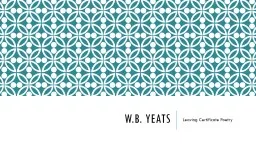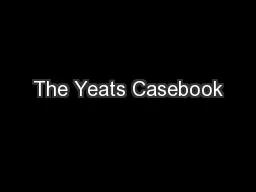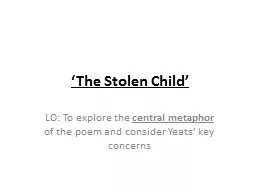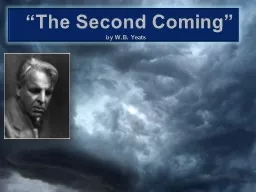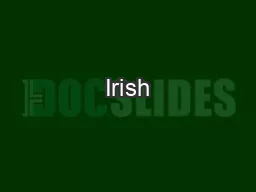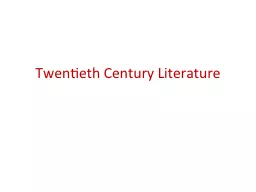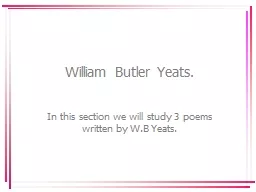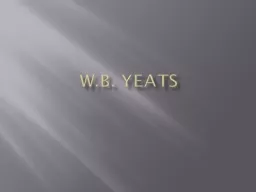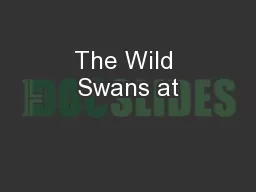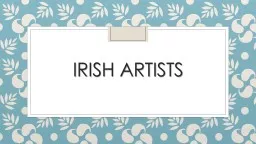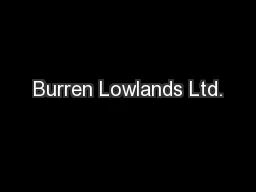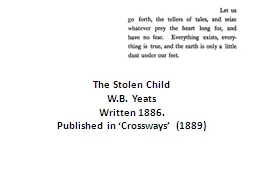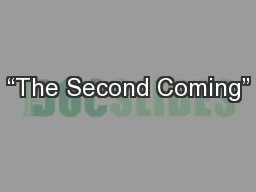PPT-W.B. Yeats
Author : lois-ondreau | Published Date : 2016-04-22
The Lake Isle of Innisfree Stanza 1 Yeats wants to go amp live on the island of Innisfree He would like to live there by himself amp lead a simple life He would
Presentation Embed Code
Download Presentation
Download Presentation The PPT/PDF document "W.B. Yeats" is the property of its rightful owner. Permission is granted to download and print the materials on this website for personal, non-commercial use only, and to display it on your personal computer provided you do not modify the materials and that you retain all copyright notices contained in the materials. By downloading content from our website, you accept the terms of this agreement.
W.B. Yeats: Transcript
The Lake Isle of Innisfree Stanza 1 Yeats wants to go amp live on the island of Innisfree He would like to live there by himself amp lead a simple life He would like to build a small cabin amp wants to grow his own food . Yeats—Irish (1865-1939). ENGL 2030—Summer 2013 | Lavery. William Butler Yeats. ENGL 2030—Summer 2013 | Lavery. "Ultimately," Rainer Maria Rilke once wrote, "there is only one poet, that infinite one who makes himself felt, here and there through the ages in a mind that can surrender to him." The Irish poet William Butler Yeats was one who surrendered. Through the mediation of his wife, Yeats was the beneficiary of an inexplicable dictation. Ellyn Willis. Becca. Zoller. Introduction. William Butler Yeats (1865-1939) was a Nobel Prize winning author of poetry and drama from Ireland. .. Yeats took part in the Irish Literary Revival as well as co-founded the Irish Theatre with Lady Gregory (became the Abbey Theatre). . LO: To explore the . central metaphor . of the poem and consider Yeats’ key concerns. Celtic Culture and Faeries. The poem was written in 1886, and published in 1889. Yeats was 21 when he wrote it, and at the beginning of his career. It celebrates the stories of Ireland that his mother loved. The images are consciously quaint. Yeats would later compile books of Irish fairy lore. . by W.B. Yeats . THE SECOND COMING. (1919). . Turning and turning in the widening gyre . . The falcon cannot hear the falconer; . . Things fall apart; the . centre. . project. 2. CREATED BY . Rafal. Surma. Irish. . Culture. . Irish culture includes customs and traditions, language, music, art, literature, folklore, cuisine and sports associated with the island of Ireland and of the Irish and Northern Irish people. However, the culture of the people living on the island is not homogeneous. There are notable cultural divides between urban and rural, Catholic and Protestants, Irish-speakers and English-speakers, immigrants and native population, the Travelers and settled population and between Northern Ireland and the Republic of Ireland. (For an overview of Ireland's culture during the Gaelic period, see Gaelic Ireland. Also for an overview of Northern Ireland's culture see Culture of Northern Ireland.). Aspects of the Twentieth Century Literature. 1- Two World Wars : economic depression, severity of life.. 2- Questioning the traditional values of Western civilization.. 3- Traditional literary forms were rejected.. In this section we will study 3 poems written by W.B Yeats.. William Butler Yeats.. The Wild Swans at . Coole. THE trees are in their autumn beauty,. The woodland paths are dry,. Under the October twilight the water. W.B. Yeats (1865-1939). B. ackground. WB Yeats was born in 1865 in Dublin. His family was upper class. . . Yeats . turned into the greatest Irish Poet of the Twentieth Century. . He spent some of his early life in London. That’s where he wrote . Coole. . Before you read:. Swans are a common subject in poetry, as well as mythology and fairy tales. With the person beside you think of as many examples of swans in stories or popular culture. Discuss what you think swans might represent or stand for.. Objectives. Study 4 Irish Artists: Jack B. Yeats, Sean Keating, Paul Henry- Painters and Eileen . Gray. – Designer. How to look . Ways Of seeing. Cover Exam questions. Breakdown of marks. Useful Resources. The story so far…. Objectives of presentation. Why? ~ Progress ~ Lessons. . O. n . the ground . perspective. Personal context. Opportunity to make a difference . Why Burren . Lowlands . was set up. Written 1886.. Published in ‘Crossways’ (1889). Objectives. To thoroughly understand the poem and the significance and influence and influence of the contexts it was written . in (A04). To develop critical understanding of how Yeats uses language, structure and form to shape meaning in the . . by W.B. Yeats . THE SECOND COMING. (1919). . Turning and turning in the widening gyre . . The falcon cannot hear the falconer; . . Things fall apart; the . centre. The Poem. A sudden blow: the great wings beating still. Above the staggering girl, her thighs caressed. By the dark webs, her nape caught in his bill,. He holds her helpless breast upon his breast.. .
Download Document
Here is the link to download the presentation.
"W.B. Yeats"The content belongs to its owner. You may download and print it for personal use, without modification, and keep all copyright notices. By downloading, you agree to these terms.
Related Documents

